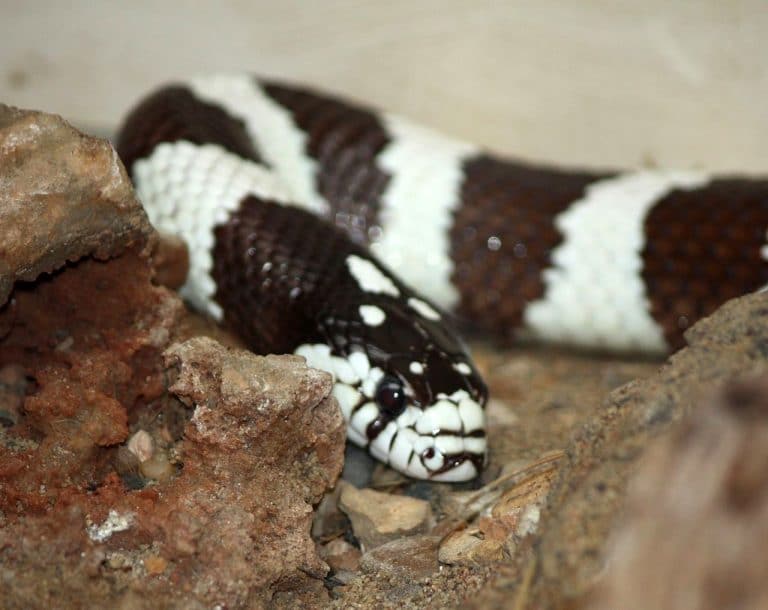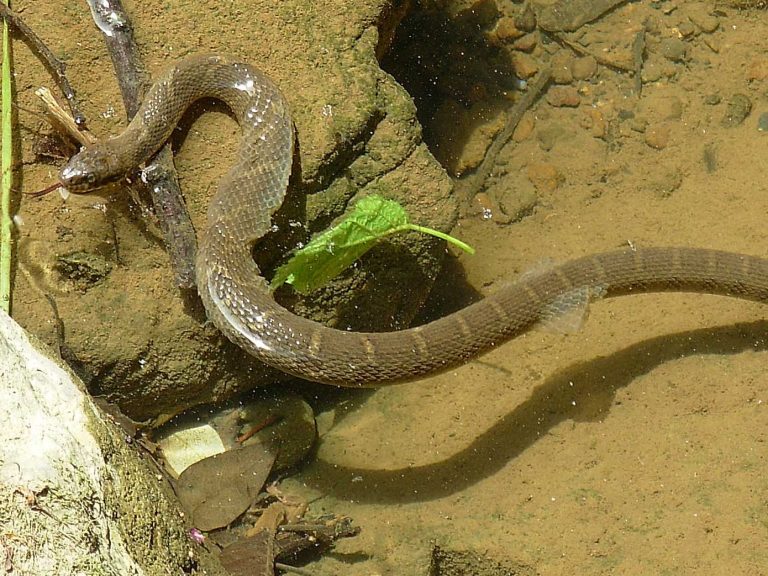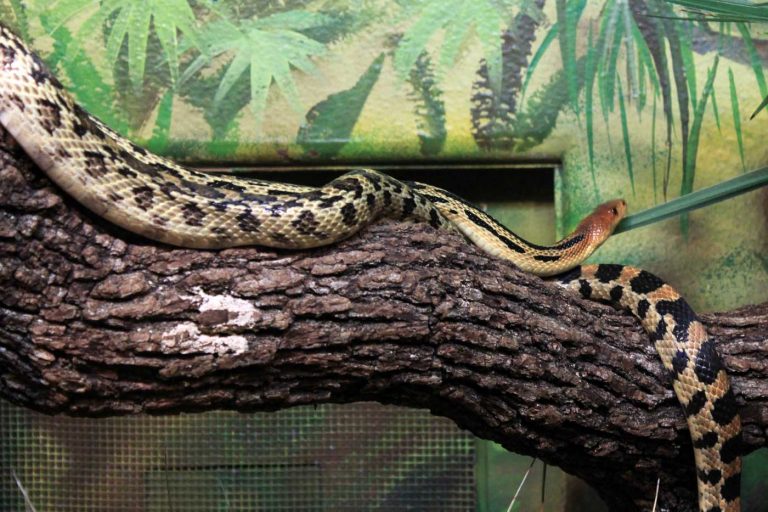Emerald Tree Boa
Scientific Classification
| Kingdom: | Animalia |
| Phylum: | Chordata |
| Subphylum: | Vertebrata |
| Class: | Reptilia |
| Order: | Squamata |
| Suborder: | Serpentes |
| Family: | Boidae |
| Subfamily: | Boinae |
| Genus: | Corallus |
| Species: | C. caninus |
| Binomial name: | Corallus caninus |
The Emerald (tree) boa belongs to the species of Boa Corallus Caninus. They are a species of non-venomous Snakes. We can find them in South America‘s rainforests. There are no recognized subspecies.

Anatomy

Adults Boas often reach a length of about 6 feet (1.8 meters). Their front teeth are well developed and relatively larger than that of other non-poisonous snakes. They display a characteristic color pattern of emerald green, with ‘lightning bolts’ (white zigzag stripes) on the back. They have yellow bellies. The boa snakes from South America display very distinctive bright color and marks. The Juveniles show diverse color variations that range between orange and brick-red. Then ontogenetic (relating to the origin and evolution of particular organisms) coloration takes over and, in a matter of 9 to 12 months, the snakes transform into an emerald green color. The Amazon basin origin species grow larger. They are more passive than their relatives from the North. They attain lengths of 7–9 feet (2.1–2.7 m), while the overall average size is closer to 1.8 meters or 6 feet. Those from the southern end of their range in Peru, tend to be darker in color.
At birth, emerald tree boas can vary from 40 to 50cm in length. They can vary in weight from 20 to 50 grams. The young are orange or reddish-brown in color. By maturity, they begin to develop their adult, emerald green color.
Behavior and Perception
Emerald tree boas locate prey primarily through sight and heat receptors located in the labial scales. These heat-sensitive pits are very useful for locating prey at night. Like other snakes, they also use their tongues as well as vomeronasal (Jacobsons) organs to sense chemical stimuli. They can detect vibrations.
Habitat
We can find these tree boa species in basin regions of, Ecuador, Colombia, northern Bolivia, Peru, and Brazil, You can see them also in Venezuela, the Guianas in South America and Suriname However, only in the Amazon river basin, do you find the similar named ‘Basin’ Variant.’ You can also find them in southern Guiana, southern Suriname, southern Venezuela, Brazil, Columbia and Peru and the jungles in the vicinity of the Amazon river.
Emerald tree boas are found at elevations that range from sea level to 1000 m above sea level (the average elevation is 200 m). These are arboreal species that spend most of their time in the rainforest canopy. You can find them in both primary and secondary vegetation, as well as swamp forests. Although they are arboreal, they do come down to the ground and bask in the sun. We find them in the Amazon Basin and often found alongside rivers, but they are not dependent on open water. They are found in areas that receive excess of 1500 mm of rain annually.
Food Habits

Emerald tree boas are nocturnal predators. They feed on rodents, lizards, and marsupials. Some researchers have suggested that they also prey on birds, but stomach content analyses have failed to substantiate this. Observations strongly indicate that emerald tree boas are ambush predators that hang near the ground and angle their heads downward and ambush rodents asw they pass by.
Predators
The only known predators of Corallus Caninus (emerald Boa) are Guianan crested eagles. Emerald tree boas are cryptically colored and generally remain hidden in the foliage.
Reproduction
C. Caninus are ovoviviparous ( live Bearers), with females giving birth to an average to 6 – 14 juveniles or more in a clutch. Rarely do litters exceed these numbers. The young juveniles display a brick-red / orange color, that with time undergoes an ontogenetic color transformation to emerald green.
As a Pet
As pets, the Emerald (tree) boa is very difficult snake to care for, especially because its requirements are specific and it is a very aggressive by nature. If you can maintain them properly, their unparalleled beauty will make them exotic in your collection.
Housing

Provide a suitable enclosure for this pet. You will need a great amount of creativity for this. These snakes are arboreal, spending a great part of their time, high up in the tree branches. You should provide the enclosure with a variety of horizontal branches of various size.s Make sure that you have a large enough enclosure to accommodate both your pet and its furnishings. Juveniles in An 18x18x24 inch dimension cage will do well for housing your exotic juvenile pets, while a 50 gallon tank can comfortably house an adult tree boa. Make sure, however, that your arboreal pet has enough branches and height to climb.
When choosing an enclosure, you would do well to keep several important points in mind. Humidity and airflow are very important in the scheme of things.. Your proposed enclosure must be designed to retain a good humidity level and at the same time, provide for good circulation of air.
Temperature
These boas are cool weather reptiles. You should provide a convenient basking spot that does not exceed a temperature of 85 F at daytime. Retain the ambient temperatures at 75 F. Make sure that night temperatures do not drop below 72 F.
Lighting
Being nocturnal, these emerald tree boa snakes do not need any special lighting.
Humidity
Since they belong to rain forest environments, you must retain humidity very high and even at 90% during the cold winter months and as low as 60% in the very dry weather. For these snakes, humidity is a very critical factor, and raising this snake in captivity will depend on how well you replicate its natural habitat conditions. To keep up the percentage of mouisture, you must take up misting on a regular basis to ensure that your pets remain hydrated all the year round.Misting twice every day will show you positive results.
Feeding

Since they are cool weather snakes, these boas have a slower digestion rate than many other snakes. They eat less frequently and take fewer meals.. If you have an adult emerald tree boa for a pet, you should feed them only once in three weeks to ensure proper digestion You can feed your juveniles once in 10 to 15 days..Rodents are a staple diet for most of the captive boas. Sometimes they will show an aversion to rodents. At such times, tempt them with an anole, quail or a gecko, and after a time, they will start to eat rodents. An important thing is to remember never to feed your pet with a prey whose circumference is larger than the maximum girth of the boa at any place in its body..
Water
Many experts advise that the Emerald Tree Boa always needs a water bowl with fresh water, but rarely do these snakes ever drink the water in the bowl or get in to soak itself. Most of the time they will sip the water from the leaves in the enclosure after misting.

Having discovered a fondness for insects while pursuing her degree in Biology, Randi Jones was quite bugged to know that people usually dismissed these little creatures as “creepy-crawlies”.







